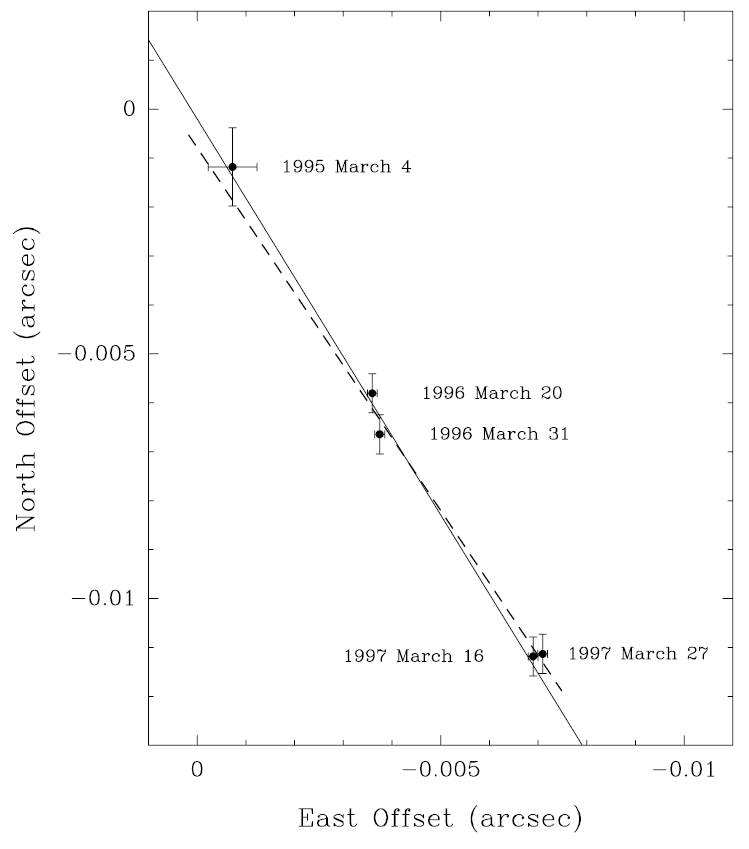
Position of Sgr A*
 المؤلف:
Heino Falcke and Friedrich W Hehl
المؤلف:
Heino Falcke and Friedrich W Hehl
 المصدر:
THE GALACTIC BLACK HOLE Lectures on General Relativity and Astrophysics
المصدر:
THE GALACTIC BLACK HOLE Lectures on General Relativity and Astrophysics
 الجزء والصفحة:
p 317
الجزء والصفحة:
p 317
 12-2-2017
12-2-2017
 2271
2271
The exact location of Sgr A* is a very important factor for its interpretation. This allows one to investigate whether the source is indeed in the Galactic Center (and not behind) and to set a lower limit on its mass. The position can be determined relatively accurately with radio observations.
This requires the use of so-called ‘phase-referencing’ observations. In this type of experiment the telescopes of a VLBI array are switched rapidly from one source to another, where both sources should be within one isoplanatic patch of the atmosphere (typically 1o-5o). Within this patch the radiation passes roughly through the same atmospheric irregularities. The switching also has to happen within the coherence time of the atmosphere at mm wavelengths the telescopes switch sources every 10 s. The phase difference of the incoming wavefronts between the two observed sources can then be used to determine the relative positions of the sources. By fixing a grid of phase-referenced sources radio quasars at cosmological distances one can then establish an absolute coordinate system, called the International Celestial Reference System (ICRF; see Ma et al 1998). Since 1997 the ICRF has been the fundamental reference system for astronomy as adopted by the International Astronomical Union (IAU).
Attempts have been made to relate the absolute position of Sgr A* to bright background quasars. The averaging of VLA observations by Yusef-Zadeh et al (1999) yielded a position for Sgr A* at the epoch 1992.4 of
α(1950) = 17h 42m 29.3076s ± 0.0007s, δ(1950) = −28o 59' 18.484'' ± 0.014'' (1.1)
α(2000) = 17h 45m 40.0383s ± 0.0007s, δ(2000)= −29o 00' 28.069'' ± 0.014''. (1.2)
A position using VLBA observations was also derived by Rogers et al (1994), which agrees with this position within 0.2''. In yet another experiment

Figure 1.2. Position of Sgr A* relative to a background quasar (J1745-283) on the plane of the sky determined from VLBA observations. North is to the top and East to the left. Each measurement is indicated with the date of observation and 1-σ error bars. The broken line is the best-fit proper motion, and the full line gives the orientation of the Galactic plane. Figure from Reid et al (1999).
Menten et al (1997) were able to relate the position of Sgr A* to the position of the near-infrared stars (emitting a radio line) surrounding it. This allows one to locate Sgr A* in a near-infrared image and try to find a counterpart.
Finally, one can also measure the relative position of Sgr A* with respect to faint background quasars which are much closer than the ICRF reference sources. Assuming that these sources are without motion on the sky (because of their cosmological distances), Reid et al (1999) (figure 1.1; see also Backer and Sramek 1999) find a proper motion for Sgr A* of −3.33 ± 0.1 mas yr−1 (E) and −4.94 ± 0.4 mas yr−1 (N), corresponding to −5.90 ± 0.35 mas yr−1 and +0.20 ± 0.30 mas yr−1 in Galactic longitude and latitude. This agrees very well with the apparent motion expected for a source at the Galactic Center due to the Galactic rotation of the solar system (220 km s−1). This implies that Sgr A* is indeed at the center of the Galaxy and has very little motion of its own (vSgr A∗ < 15 km s−1). This is interesting, shown that stars near Sgr A* move in the deep potential well with velocities up to 1500 km s−1. The most likely reason for this is, of course, that Sgr A* itself causes this potential well. One can use the assumption of equipartition of momentum between the fastest stars (m∗v∗) and Sgr A* (MSgr A∗ vSgr A∗) to infer a lower limit on the mass of Sgr A* from the VLBI proper motion studies:
 (1.3)
(1.3)
Numerical modeling of n-body interactions suggests that under most conditions this lower limit can be as high as 105 Mּ (Reid et al 1999). This mass is way beyond those of any stellar object and hence it is very reasonable to assume that essentially all the dark mass of 2-3 × 106 Mּ is concentrated inside Sgr A* the radio source.
 الاكثر قراءة في الثقوب السوداء
الاكثر قراءة في الثقوب السوداء
 اخر الاخبار
اخر الاخبار
اخبار العتبة العباسية المقدسة


